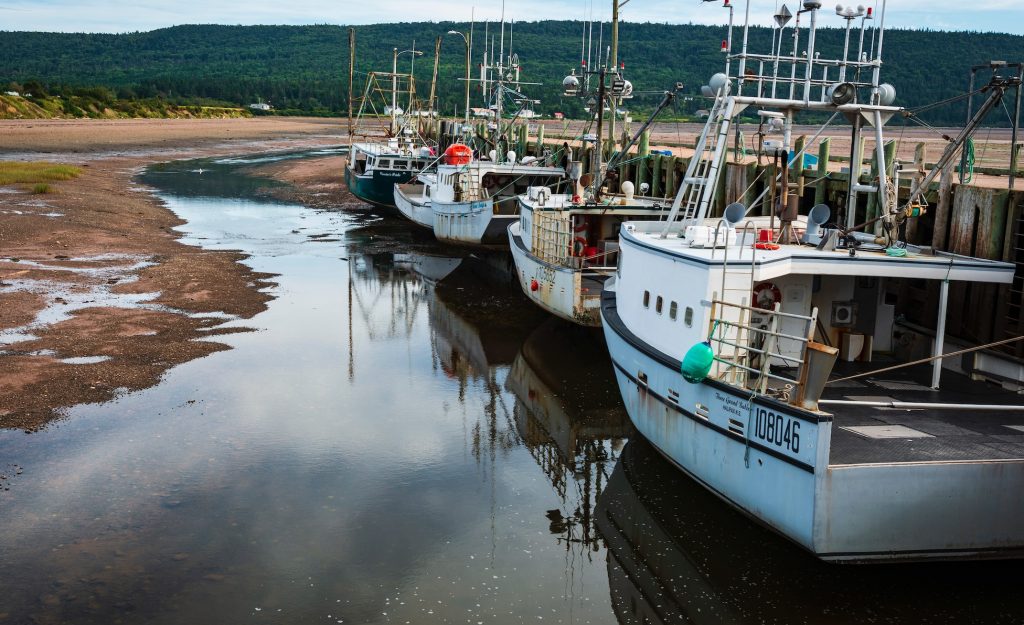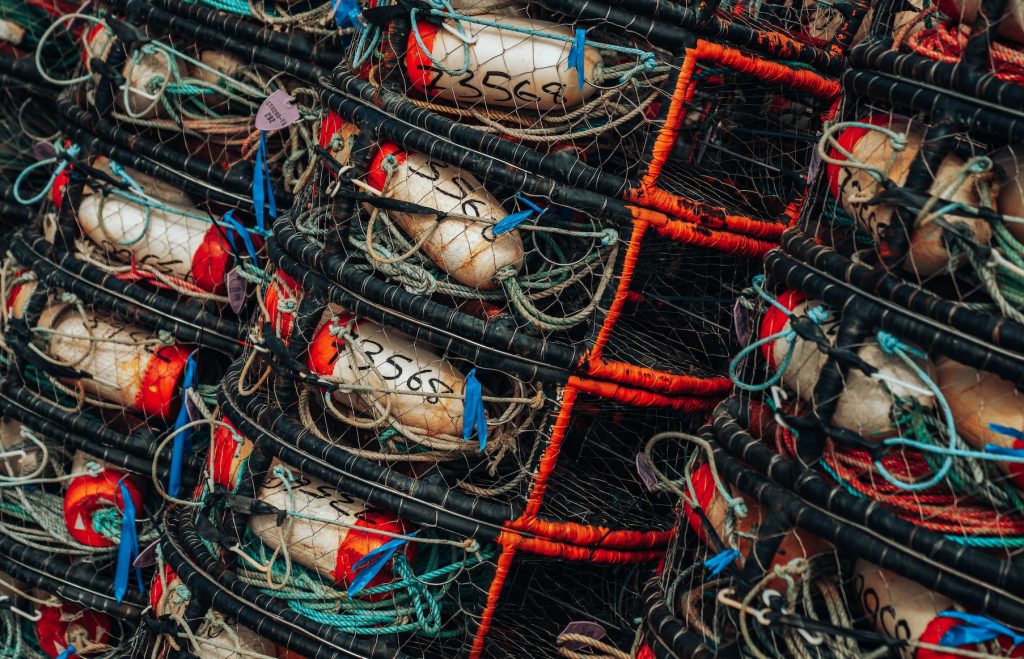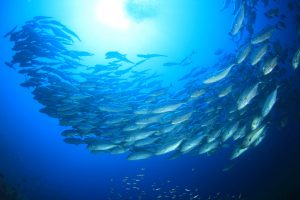With a theatrical trailer that had all the bells and whistles of a Liam Neeson action flick, Netflix documentary Seaspiracy has climbed the streaming platform’s ranks to earn a spot on its Top 10 most popular shows and films.
But weeks after its release, the 90-minute movie is receiving criticism from some experts for telling viewers to give up consuming fish entirely and for misrepresenting the science with old data.
University of Washington marine biologist and fisheries scientist Ray Hilborn went so far as to call Seaspiracy a “propaganda film made by vegan activists that makes no attempt to present the issues and provide any perspective, [which] contains more lies than a Donald Trump press conference.”

Boats lined up against the Government Wharf in Advocate Harbour, Nova Scotia. While the new Netflix documentary Seaspiracy argues there’s no such thing as a sustainable fishery, some scientists disagree. (Jamie Morrison/Unsplash)
While not all fishery experts would describe the film in such bold terms, many agree Seaspiracy was a lost opportunity to provide constructive solutions to a complex problem.
“Instead of providing viable recommendations to address the issues plaguing the fishing industry, Seaspiracy decided to tell viewers to simply stop eating fish,” tweeted University of Windsor marine ecologist Eric Ste Marie. “It’s an option for wealthy city-dwellers, but not for the majority of people relying on the oceans for food and a living.”
Ste Marie studies Greenland sharks near Nunavut’s Mittimatalik, or Pond Inlet, where his Inuit colleagues rely on ocean species like seal and char for sustenance.
He told SUSTAIN that the film, billed as an investigation into the global ocean plastic problem, misses the mark by summarizing the content of documentaries like The Cove and The End of the Line while misinforming its viewers with sensational statistics.
Ultimately, he said it does more harm than good.
“If you’re making statements that a quick, five-minute Google search can debunk, then it’s easy for people who don’t care about the issue to [reject] the other points made in the film,” said Ste Marie. “And it’s a huge problem, obviously, because it is just such a seismic issue.”
Indigenous communities in Canada rely on harvests
In the nearly 30 years since Canada imposed a cod moratorium, the fishery economy has remained a lucrative one that generates billions of dollars annually.
Illegal fishing, mislabelling species, a lack of government transparency and the underreporting of bycatch caught by trawlers are problems that have been reported in Canada’s fishery industry. But not all fisheries are created equally, and the implications of a total cessation of fish consumption could be devastating.
“When you make these kinds of blanket statements like ‘there’s no such thing as a sustainable fishery,’ it makes it easy for people to just have these cut and dry opinions on things without realizing there are going to be unintended casualties to that mindset,” said Ste Marie.
For Indigenous communities in Canada who rely on harvesting fish for economic and cultural purposes, those unintended casualties are two-fold.
Emmanuel Sandt-Duguay is the Commercial Fisheries Liaison Coordinator for the Mi’gmaq and Maliseet Aboriginal Fisheries Management Association, where he works with six communities in New Brunswick and Quebec that rely on lobster, snow crab, mackerel and herring harvests among others.
“Fisheries have been important to the Mi’gmaq and Maliseet for thousands of years. It’s part of their culture, but now it’s really important economically too,” said Sandt-Duguay, who directly works with the Maliseets of Wolastoqiyik Wahsipekuk, the Mi’gmaqs of Gesgapegiag and the Mi’gmaqs of Gespeg.
Sandt-Duguay says that the Maliseet community, for example, earns 80 per cent of their gross income comes from fisheries. He said that fisherfolk will adjust the harvest of different species based on stock size and health.
“All the fishermen are really conscious that they work with the sea and nature and they want to live with the stocks that procures them food in the long-term,” he said. “It’s not to destroy the stocks or to take more, they take what they need or what nature can support.”
Fishery economist agrees fishery subsidies are a problem
On a global scale, small-scale fisheries—like those Sandt-Duguay liaises with—employ more than 90 percent of capture fishers, according to the Food and Agriculture Organization. But small-scale fisheries only receive only a fraction of the government subsidies available to the industry.
The distribution ratio, fisheries economist Rashid Sumaila said, is 20 per cent for small-scale fisheries and 80 for large-scale operations.

Stacks of worn crab traps await fishing season in Bodega Bay, California. Only 20 per cent of fishery subsidies are awarded to small-scale fisheries, while 80 per cent fund large industrial operations (Meritt Thomas / Unsplash).
Seaspiracy’s claim that subsidies fuel overexploitation and disproportionately benefit big business is one that the UBC Professor and Canada Research Chair with the Institute for the Oceans and Fisheries can get behind.
After nearly 20 years of tracking subsidies, he and his colleagues estimate that 22 of the 35 billion dollars given to the world’s marine fisheries annually are harmful and can stimulate overfishing.
“You fish more than you would if the subsidies weren’t there,” he said, stating that harmful subsidies need to be redirected towards sustaining fish stocks instead of depleting them. “If someone’s paying for part of your fuel, you’re going to fish harder, longer and deeper.”
While subsidies are evidently a problem and require more regulation and equitable distribution, he said asking the world to call it quits on fish isn’t the answer.
“I mean I’d be happy if people reduced their fish intake because demand is a big push for everything,” said Sumaila. “But to say we should all stop eating fish, it doesn’t seem to me they understand what fish mean for so many people in the world.”
He said that abroad, for some communities in regions like West Africa or South East Asia, fish may be the only animal protein people can access. Steps to diversify a community’s economy to make them less reliant on a single form of harvest should be taken before asking a community to go vegetarian or vegan.
The onus should be on governments and distributors, not just the consumer
There’s no doubt that consumer decisions have power in the marketplace. In recent years, companies have taken social, environmental and sometimes political stances to appeal to consumers.
But when it comes to protecting stocks, consumer behaviour can only do so much.
“I don’t believe that consumers alone can do this job, it’s too much to ask, and that’s why we have governments and institutions,” Sumaila said, adding that people who want to make a difference should vote in governments that prioritize environmental protection.
So far, the Trudeau government has made good on—even surpassing—some of its campaign promises around ocean protection. Marine Protected Areas (MPAs) have increased by almost 1,000 per cent under the administration.
Canada has also pledged to sustainably manage 100 per cent of its oceans by 2025 and joined the United Kingdom-led Global Ocean Alliance last July to commit to conserving 30 per cent of the country’s oceans by 2030.
But the government has also been criticized for its lack of transparency across several issues. Overfishing, Sumaila said, is a problem for which the government needs to improve the availability of public data.
Scott Wallace, Senior Research Scientist with the David Suzuki Foundation and a Steering Committee Member for SeaChoice, said that while he didn’t have major qualms with the documentary’s content, the take-home message ignores the realities of feeding a growing population.
“You can’t have 8 billion people on the planet and not have access to 99.5 per cent of the biological space, there’s no easy way out of a food system,” he said. “It’s going to have an ecosystem impact, no matter where it comes from.”
Oceans, he said, are wild ecosystems that can be harvested in a way that generally maintains the ecosystem’s structure. Agriculture, on the other hand, typically results in the permanent conversion of a wild ecosystem into a human-dominated one.
“From a broader food system, it’s probably better for biodiversity to access some of the oceans, some of the land and do all of these things better.”
Echoing Sumaila, Wallace said it shouldn’t have to be up to the consumer to choose sustainable seafood to eat. It should be up to retailers and the seafood distributors, he said, to provide ethically sourced and sustainable products to consumers.
“In the long run, it has to be addressed through laws, policies, government trade, things like that. If it’s up to the individual, that’s a hard model for making change.”

School of Bigeye Trevally fish (Jackfish) underwater photo in the Similan Islands, Thailand
Additional responses from Canadian experts:
Read OceanWise’s response to the film
Read the Marine Stewardship Council’s response to the film
About the author:
Jade Prévost-Manuel is a Canada- and Caribbean-raised multimedia journalist. She writes stories on science, culture, travel and occasionally sports. Got a tip? Reach her on Twitter at @prevost_manuel.

